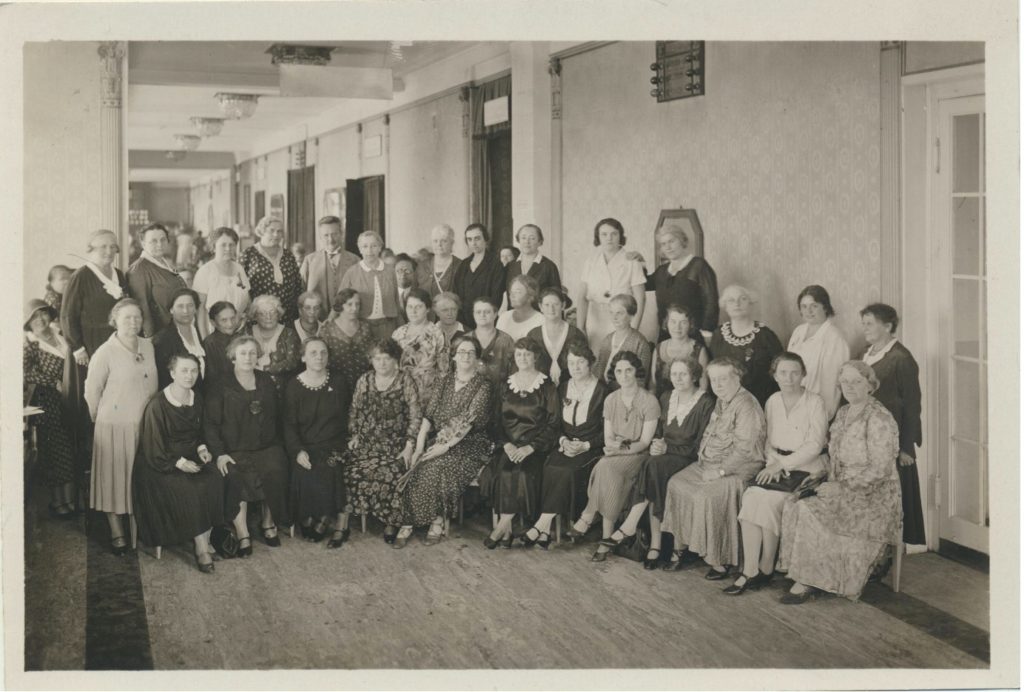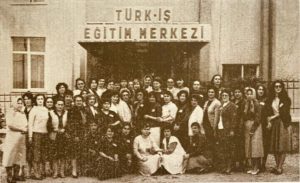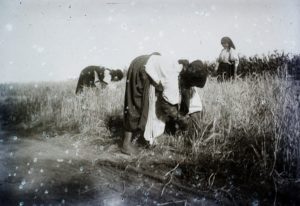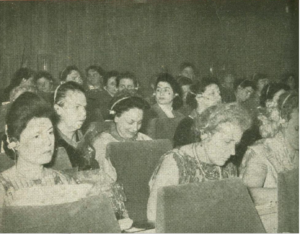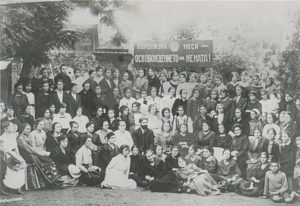by Alexandra Ghit
In August of 1931, Marion Phillips proudly explained about the Fourth International Socialist Women’s Conference: “In the Women’s Conference we are trying to get something which is new in the history of the world; we are trying to formulate a body of doctrine with regard to women’s problems seen through the eyes of the women themselves.”[1] Phillips (Labour Party, Great Britain) made this statement in her formal report on the Conference, addressed to the plenum of the Congress of the Labour and Socialist International (LSI), happening in Vienna. The three-day Women’s Conference, also held in Vienna, had ended the previous week.
Phillips’s formulation was referencing recent, complex, and very concrete struggles of prominent women’s labour activists to create “international safeguards” for (married) women’s right to work and the principle of equal pay.[2] Yet her words in the Vienna conference hall also suggest a movement’s broader attempt, of bringing together global policy ambitions and ground-up inquiry methods.
How did this striking vision fare at a women’s conference organized in the framework of a transnational social democratic federative body (the LSI) that was male-dominated?[3] What can the fourth Conference of the LSI women reveal about the entangled development of but also the key differences in Western and non-Western European social democratic women’s labour organizing in the interwar period?
In this blog post I show that the 1931 Fourth Socialist Women’s Conference’s agendas and resolutions were broadened, indeed made less narrowly West European, by the greater participation that year of women delegates from East European countries. The reported experiences and oral interventions in preparation for and during the Conference by women’s representatives from Poland, Hungary, Czechoslovakia and Romania, among others, brought novel urgency to issues such as the need to create international policies that protected agrarian workers and the struggle against fascism.
In hindsight, the 1931 LSI women’s Fourth International Conference was an unprecedented and then unmatched point in the history of cooperation among social democratic Western and Eastern European women activists, and a peak in social democratic women’s activism in Europe in general. In the opening speech of the Conference, Adelheid Popp (Social Democratic Party, Austria), leading figure of the women’s branch of the LSI, argued that in 1930 there had been no fewer than 1,280,000 women who were members of LSI-affiliated parties, several tens of thousands more than in 1928. In her report to the LSI Congress, Phillips pointed out that the Women’s Conference had been larger, more effective and much better attended by women from newer and smaller social democratic movements than ever before.[4] These newly affiliated and newly-participating delegates came especially from Eastern Europe.[5]
Certainly, by 1931, the sheer difference of magnitude between some of the national social democratic women’s organizations represented at LSI Women’s Conferences was staggering. The Austrian Social Democratic Party, one of the largest on the continent, had over 200,000 women members, the Polish Socialist Party (even in the Piłsudski regime) claimed several tens of thousand women members, as did the Hungarian Social Democratic Party (weakened by the Horthy regime as it was).[[6] By contrast, the Bulgarian, Greek, Lithuanian or Romanian parties had between 300 and 1400 women members in 1928, on the background of much smaller labour movements overall. The organizations from Czechoslovakia and Poland were represented in (and had helped create) the LSI International Advisory Committee on Women (IACW), while the three-person Romanian women’s delegation to Vienna was congratulated for having managed to be present for the first time at an LSI Women’s Conference – “especially when it is due to the efforts of the women themselves” who operated within/collaborated with an unsupportive national organization.[7]
In this context, in Vienna, and in reports laid before the 1931 (and earlier) conferences, Eastern European delegates underscored both similarities and differences in their work, compared to their Western European comrades. For instance, for their country report for the 1928 Third International Women’s Conference (held in Brussels), Hungarian representatives pointed out that “the organizing methods [for social democratic women] are similar to those in Germany and Austria, (…) but with the great difference that the political movement has far fewer means at its disposal”. And again, in 1931, they highlighted that it was difficult to ask women to pay any kind of dues as “one must remember that Hungarian women live in a state of misery which seems almost unbelievable to West Europeans”.[8]
Significantly, the emphasis on deep differences within Europe as well as the greater visibility of participants from countries not belonging to the Western and Central European (social democratic) core visibly shaped the final stances adopted at the 1931 Conference.
First, a discussion on how to struggle for better social policies for women working in agriculture referred especially to the situation in the predominantly agrarian Eastern European countries. The Dutchwoman Elisabeth Ribbius Peletier presented an initial report on the situation of women in agriculture. During discussions, Dorota Kłuszyńska (representing affiliated Polish women) highlighted: “The agrarian question is urgent, especially in the countries of the East. (…) Therefore, it is of great importance that the question is to be dealt with internationally.”[9] Luise Schroeder, one of the delegates from Germany, used the information provided by the Romanian delegation to emphasize the necessity of a comprehensive discussion of the issue.[10]
Marion Phillips’s report to the LSI Congress reveals the impact of the non-Western angle on the stances which were eventually adopted by the Women’s Conference:
The succeeding resolution deals with women in agriculture, and here I am a very bad rapporteur, for women in agriculture represent but a small portion of the general wage-earning life of our country [England]. We are, however, able, through the work of others who have a bigger problem in their lands, to put before you something which we believe would ease the hard lot of women who are proletarian workers upon the land…[11]
Secondly, a draft resolution and speeches by women’s representatives from the historically prominent social democratic parties in Hungary and Poland, outlining the significant fascist repression and economic troubles they were facing, underscored the urgency of the entire LSI to take a public stance against fascism, regardless of the actual political situation in the various countries represented. Conference speeches by delegates from Germany, particularly Toni Sender’s, also sounded a sharp alarm against the danger posed by Hitler and fascism in Europe.[12] The experiences of living in authoritarian regimes, shared by Eastern European comrades in the 1931 conference, but also made visible for instance, by Kłuszyńska’s correspondence with the IACW beginning with 1929,[13] were also crucial for producing a strongly-worded antifascist Conference resolution. “You hold treasures in your hands, you have very much to lose” presciently warned the embattled Hungarian social democrat Anna Kéthly from the Conference podium located in (still) Red Vienna.[14]
The adopted resolution, on “Political reaction and its effect on the emancipation of women”, linked the rise of fascism with the decline of working women’s rights, and argued that “women united in the LSI are therefore aware that it is their duty to stand in the front line in the fight against fascism and reaction”.[15] This resolution helped transform support for women’s right to work into a key marker of progressive politics and anti-fascism across Europe, in various international fora, even as fascism became dominant in Central and Eastern Europe in the second half of the 1930s.[16]
There would be no Fifth International Socialist Women’s Conference, as fascist and authoritarian regimes banned or terrorized left-wing organizers throughout much of Europe after 1931. Later in the 1930s, as the center of weight in the LSI (including within the Conference-organizing IACW) switched towards the non-repressed Scandinavian and British social democratic parties,[17] consideration of social protection in agriculture or the profound unevenness of working women’s experiences across Europe fell somewhat from sight. Still later, during the Cold War, as Eastern European social democracy no longer flourished, the intensive exchange and cooperation between Western and Eastern European women from social democratic parties, enabled by the 1931 conference, could not be reprised.
In the Introduction to this blog series we posed the question: „Does ‘thinking transnationally’ bring a substantive change to our understanding of the history of women’s labour activism in the long perspective“? In this post I sought to provide a sketch of where a transnational perspective that looks not only at open exchange but also at hierarchy can lead with regard to the history of women’s labour activism and political organizing. I have shown how the Fourth International Socialist Women’s Conference made visible the circulation of organizational practices (repertoires) and claims (agendas) but also revealed significant differences, especially with regard to the means available for organizing. Also, I have shown how transnational organizing both constructs and dismantles hierarchies. I have done so by focusing on a moment in time when a transnational forum enabled discussion of inequalities within Europe but also raised awareness about common threats. In particular, the shared stance of the “weaker” Eastern European delegations and the “stronger” Austrian and German ones, that fascism posed an urgent threat, marked (but could not change) ulterior developments. Much remains to be done for my research on the topic but the small discoveries I made so far are encouraging and exciting.
[1] Fourth International Women’s Conference of the Labor and Socialist International, Vienna, July 23rd to 25th, 1931: Report of the Secretariat to the Women’s Conference and Proceedings of the Women’s Conference (Zurich, Zurich Canton: Labour and Socialist International Archives, International Institute of Social History. Labour and Socialist International, 1931), IX.95, accessed via the database Alexander Street -“Women and Social Movements, International – 1840 to Present,” ed. Thomas Dublin and Kathryn Kish Sklar, https://search.alexanderstreet.com/wasi.
[2] Susan Zimmermann, “Framing Working Women’s Rights Internationally: Contributions of the IFTU Women’s International,” in The Internationalisation of the Labour Question. Ideological Antagonism, Workers’ Movements and the ILO since 1919, ed. Stefano Bellucci and Holger Weiss (Houndsmills and New York: Palgrave Macmillan, 2020), 103–4.
[3] Established in 1923, the Labour and Socialist International (LSI)/ Sozialistische Arbeiterinternationale (SAI) was a loose federation of around thirty European social democratic parties; affiliated parties were represented in the LSI executive according to the size and power of a party in its domestic context. Within the LSI, women’s labour and political activism enjoyed a consistent support but LSI women labour activists had limited decision-making power. Women’s Conferences were held alongside LSI Congresses, once every two or three years, in Hamburg (1923), Marseille (1925), Brussels (1928) and Vienna (1931). From 1927 on, there functioned an International Advisory Committee on Women (IACW), a body set up after years of insistence by several women of influence within social democratic national movements or in the LSI; membership in the committee was linked to the strength of women’s organizing in the various social democratic parties affiliated to the LSI. Until 1939, when the LSI as a whole ceased to exist, the IACW gathered and synthesized information about the various social democratic women’s organizations from parties affiliated to the LSI, and produced reports, press materials, questionnaires on issues of common interest for members, and organized the periodical Women’s Conferences. Notably, IACW members had ties with the Women’s International in International Federation of Trade Unions (IFTU, or so-called “Amsterdam International”), but they represented the political arm (rather than the closely-related trade union arm) of social democracy in an international setting. Silke Neunsinger, “Creating the International Spirit of Socialist Women. Women in the Labour and Socialist International 1923-1939,” in Crossing Boundaries. Women’s Organizing in Europe and the Americas, 1880-1940s, ed. Pernila Jonsson, Silke Neunsinger, and Joan Sangster (Uppsala Universitet, 2007), 117–56.
[4] 23rd to 25th, 1931: Report of the Secretariat to the Women’s Conference and Proceedings, IX.94.
[5] At the previous, 1928 Brussels conference, social democratic women from the following non-Western European countries were represented: Yugoslavia, Latvia, Lithuania, Poland, Russia, Hungary and (the disputably non-Western at the time) Czechoslovakia. By 1931, there were delegations from Bulgaria, Czechoslovakia, Estonia, Greece, Hungary, Latvia, Lithuania, Poland, Romania and Russia. Bericht über die dritte internationale Frauenkonferenz der S.A.I.: Salle des Conferences des Volkshauses in Brüssel, 3.-4. August 1928 [Report on the Third International Women’s Conference of the LSI.: Salle des Conferences of the People’s House in Brussels, August 3-4, 1928], vol. 2 (Zurich, Zurich Canton: Labour and Socialist International, 1928), VIII.57, accessed via the database Alexander Street -“Women and Social Movements, International – 1840 to Present,” ed. Thomas Dublin and Kathryn Kish Sklar, https://search.alexanderstreet.com/wasi.
[6] Die Frauen in der Sozialistischen Arbeiter-Internationale: Bericht vorgelegt der Dritten Internationalen Frauenkonferenz der S.A.I. und dem Dritten Kongress der S.A.I. von Sekretariat der SAI [Women in the Labour and Socialist International: Report Presented to the Third International Women’s Conference of the S.A.I. and the Third Congress of the LSI and the Secretariat of the LSI], vol. 1 (Zurich, Zurich Canton: Labour and Socialist International, 1928), III.9, accessed via the database Alexander Street -“Women and Social Movements, International – 1840 to Present,” ed. Thomas Dublin and Kathryn Kish Sklar, https://search.alexanderstreet.com/wasi..
[7] 23rd to 25th, 1931: Report of the Secretariat to the Women’s Conference and Proceedings, IX.77.
[8] Die Frauen in der Sozialistischen Arbeiter-Internationale, 1:III.12; 23rd to 25th, 1931: Report of the Secretariat to the Women’s Conference and Proceedings, IX.22.
[9] 23rd to 25th, 1931: Report of the Secretariat to the Women’s Conference and Proceedings, IX.54.
[10] “We must be clear which views have so far opposed the extension of social policy to agriculture. On the one hand, there is the view that still many more patriarchal relations dominate in the country than in town industries. The second view has been so graphically brought before our eyes by our comrades from Rumania, namely, the view that not only women wage-earners doing subordinate work in agriculture, but also the majority of the farmer’s wives belong to the most exploited of human beings. These two views views which we find in our own countries, if not so marked in degree as in Rumania, have nevertheless stood in the way of social policy in agriculture up to the present. (…) What is the position then with the so-called patriarchal relations on the land? What was once a protection for the workers has long been removed. ” 23rd to 25th, 1931: Report of the Secretariat to the Women’s Conference and Proceedings, IX.46 In my preliminary reading, Schroeder’s abridged (and somewhat convoluted) explanation was meant to counter two types of arguments circulating in both Eastern and Western Europe at the time. First, that a supposedly still-existing rural paternalism or rural community ties (“patriarchal relations”) offered a kind of community-based protection for workers, so that social protection measures were not necessary in agriculture, unlike in urban-based industrial settings. Secondly, that exploitation was as bad for landed farmer’s wives (because they were themselves heavily exploited) as for the agricultural labourers such landed farmers may be employing – here, I would argue, Schroeder was combatting a common discursive strategy of the period, that of pitting women’s oppression against workers’ oppression to diminish gains for both categories.
[11] 23rd to 25th, 1931: Report of the Secretariat to the Women’s Conference and Proceedings, IX.98.
[12] 23rd to 25th, 1931: Report of the Secretariat to the Women’s Conference and Proceedings, IX.12.
[13] Dorota Kłuszyńska, “Draft report. Der Frauentag der Sozialistischen Polnischen Partei P.P.S. [The Women’s Day of the Polisch Socialist Party P.P.S.],” June 24, 1929, ARCH01368.4392, Labour and Socialist International Archive (Digitized), International Institute for Social History, Amsterdam, Netherlands. Online archive., https://hdl.handle.net/10622/ARCH01368.4392.
[14] 23rd to 25th, 1931: Report of the Secretariat to the Women’s Conference and Proceedings, IX.23.
[15] 23rd to 25th, 1931: Report of the Secretariat to the Women’s Conference and Proceedings, IX.83-84.
[16] Zimmermann, “Framing Working Women’s Rights Internationally: Contributions of the IFTU Women’s International,” 103.
[17] Neunsinger, 139, 151.
Illustration:
Participants at the International Women’s Conference in the Framework of the Congress of the Labour and Socialist International (LSI) in the Vienna Konzerthaus. 1931. Photograph, 12 x 17,5. N19/1, Personenarchiv L22, Zusatzmappe Gabriele Proft (Nachlass Gabriele Proft). Reproduction permission for ZARAH Blog courtesy Verein für Geschichte der ArbeiterInnenbewegung [Association for the History of the Labour Movement] (VGA), Vienna, Austria. (With thanks to Georg Spitaler [VGA] for his support.)

